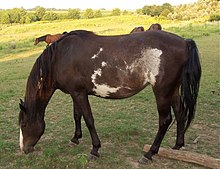A horse breed is a selectively bred population of domesticated horses, often with pedigrees recorded in a breed registry. However, the term is sometimes used in a broader sense to define landrace animals of a common phenotype located within a limited geographic region, or even feral “breeds” that are naturally selected. Depending on definition, hundreds of "breeds" exist today, developed for many different uses. Horse breeds are loosely divided into three categories based on general temperament: spirited "hot bloods" with speed and endurance; "cold bloods," such as draft horses and some ponies, suitable for slow, heavy work; and "warmbloods," developed from crosses between hot bloods and cold bloods, often focusing on creating breeds for specific riding purposes, particularly in Europe.

The Morgan horse is one of the earliest horse breeds developed in the United States. Tracing back to the foundation sire Figure, later named Justin Morgan after his best-known owner, Morgans served many roles in 19th-century American history, being used as coach horses and for harness racing, as general riding animals, and as cavalry horses during the American Civil War on both sides of the conflict. Morgans have influenced other major American breeds, including the American Quarter Horse, Tennessee Walking Horse and the Standardbred. During the 19th and 20th centuries, they were exported to other countries, including England, where a Morgan stallion influenced the breeding of the Hackney horse. In 1907, the US Department of Agriculture established the US Morgan Horse Farm near Middlebury, Vermont for the purpose of perpetuating and improving the Morgan breed; the farm was later transferred to the University of Vermont.The first breed registry was established in 1909, and since then many organizations in the US, Europe and Oceania have developed. There were estimated to be over 175,000 Morgan horses worldwide in 2005.
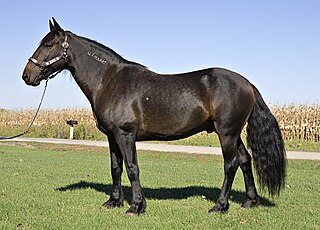
The mustang is a free-roaming horse of the Western United States, descended from horses brought to the Americas by the Spanish. Mustangs are often referred to as wild horses, but because they are descended from once-domesticated animals, they are actually feral horses. The original mustangs were Colonial Spanish horses, but many other breeds and types of horses contributed to the modern mustang, now resulting in varying phenotypes. Some free-roaming horses are relatively unchanged from the original Spanish stock, most strongly represented in the most isolated populations.

Colonial Spanish horse is a term for a group of horse breed and feral populations descended from the original Iberian horse stock brought from Spain to the Americas. The ancestral type from which these horses descend was a product of the horse populations that blended between the Iberian horse and the North African Barb. The term encompasses many strains or breeds now found primarily in North America. The status of the Colonial Spanish horse is considered threatened overall with seven individual strains specifically identified. The horses are registered by several entities.
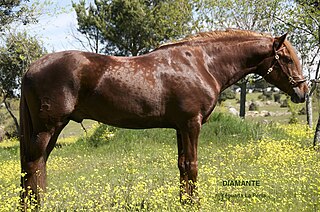
The Lusitano, also known as the Pure Blood Lusitano or PSL, is a Portuguese horse breed, closely related to the Spanish Andalusian horse. Both are sometimes called Iberian horses, as the breeds both developed on the Iberian peninsula, and until the 1960s they were considered one breed, under the Andalusian name. Horses were known to be present on the Iberian Peninsula as far back as 20,000 BC, and by 800 BC the region was renowned for its war horses. The fame of the horses from Lusitania goes back to the Roman Age, which attributed its speed to the influence of the West wind, who was considered capable of fertilizing the mares. When the Muslims invaded Iberia in 711 AD, they brought Barb horses with them that were crossed with the native horses, developing a horse that became useful for war, dressage and bull fighting. In 1966, the Portuguese and Spanish stud books split, and the Portuguese strain of the Iberian horse was named the Lusitano, after the word Lusitania, the ancient Roman name for the region that modern Portugal roughly occupies. There are four main breed lineages within the breed today, and characteristics differ slightly between each line.

The Sorraia is a rare breed of horse indigenous to the portion of the Iberian peninsula, in the Sorraia River basin, in Portugal. The Sorraia is known for its primitive features, including a convex profile and dun coloring with primitive markings. Concerning its origins, a theory has been advanced by some authors that the Sorraia is a descendant of primitive horses belonging to the naturally occurring wild fauna of Southern Iberia. Studies are currently ongoing to discover the relationship between the Sorraia and various wild horse types, as well as its relationship with other breeds from the Iberian Peninsula and Northern Africa.
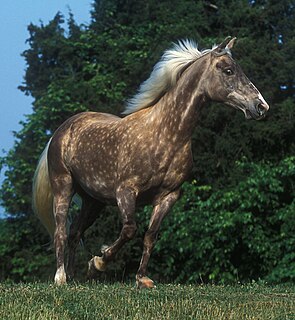
The Rocky Mountain Horse is a horse breed developed in the state of Kentucky in the United States. Despite its name, it originated not in the Rocky Mountains, but instead in the Appalachian Mountains. A foundation stallion, brought from the western United States to eastern Kentucky around 1890, began the Rocky Mountain type in the late 19th century. In the mid-20th century, a stallion named Old Tobe, owned by a prominent breeder, was used to develop the modern type; today most Rocky Mountain Horses trace back to this stallion. In 1986, the Rocky Mountain Horse Association was formed and by 2005 has registered over 12,000 horses. The breed is known for its preferred "chocolate" coat color and flaxen mane and tail, the result of the relatively rare silver dapple gene acting on a black coat, seen in much of the population. It also exhibits a four-beat ambling gait known as the "single-foot". Originally developed as a multi-purpose riding, driving and light draft horse, today it is used mainly for trail riding and working cattle.

The Nokota horse is a feral and semi-feral horse breed located in the badlands of southwestern North Dakota in the United States. The breed developed in the 19th century from foundation bloodstock consisting of ranch-bred horses produced from the horses of local Native Americans mixed with Spanish horses, Thoroughbreds, harness horses and related breeds. The Nokota was almost wiped out during the early 20th century when ranchers, in cooperation with state and federal agencies, worked together to reduce competition for livestock grazing. However, when Theodore Roosevelt National Park was created in the 1940s, a few bands were inadvertently trapped inside, and thus were preserved.
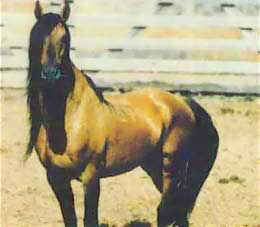
The Kiger mustang is a strain of mustang horse located in the southeastern part of the U.S. state of Oregon. Feral horses with specific conformation traits discovered in 1977, the name applies only to wild-captured individuals and does not apply to their bred-in-captivity progeny, which are known as Kiger horses. The Bureau of Land Management (BLM) administers two herd management areas for Kiger mustangs in the Burns District—Kiger and Riddle Mountain, in the Steens Mountain area. DNA testing has shown that Kiger mustangs are descended largely from Spanish horses brought to North America in the 17th century, a bloodline thought to have largely disappeared from mustang herds before the Kiger horses were found.
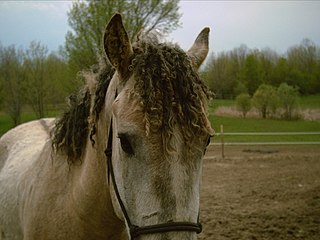
A Curly is a breed of horse. Curlies, also called Bashkir Curlies, American Bashkir Curlies, and North American Curly Horses, come in all sizes, colors, and body types but all carry a gene for a unique curly coat of hair.
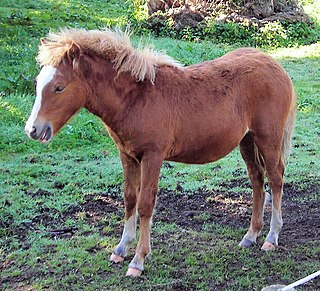
The Kerry Bog Pony is a mountain and moorland breed of pony that originated in Ireland. Possibly descended from the Irish Hobby horse, it originally lived a mainly feral existence in the peat bogs of what is now County Kerry in southwestern Ireland. Local inhabitants used the ponies as pack and cart horses for transporting peat and kelp to the villages. The breed developed physical characteristics including a low weight-to-height ratio and an unusual footfall pattern, which helped it move on soft ground such as peat bogs. The ponies were known for hardiness and an ability to survive in harsh conditions.

The Banker horse is a breed of feral horse living on barrier islands in North Carolina's Outer Banks. It is small, hardy, and has a docile temperament. Descended from domesticated Spanish horses and possibly brought to the Americas in the 16th century, the ancestral foundation bloodstock may have become feral after surviving shipwrecks or being abandoned on the islands by one of the exploratory expeditions led by Lucas Vázquez de Ayllón or Sir Richard Grenville. Populations are found on Ocracoke Island, Shackleford Banks, Currituck Banks, Cedar Island, and in the Rachel Carson Estuarine Sanctuary.

The Carolina Marsh Tacky or Marsh Tacky is a rare breed of horse, native to South Carolina. It is a member of the Colonial Spanish group of horse breeds, which also include the Florida Cracker Horse and the Banker horse of North Carolina. It is a small horse, well adapted for use in the lowland swamps of its native South Carolina. The Marsh Tacky developed from Spanish horses brought to the South Carolina coast by Spanish explorers, settlers and traders as early as the 16th century. The horses were used by the colonists during the American Revolution, and by South Carolinians for farm work, herding cattle and hunting throughout the breed's history.
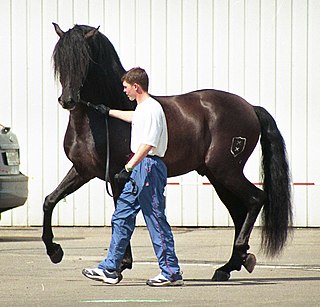
The Andalusian, also known as the Pure Spanish Horse or PRE, is a horse breed from the Iberian Peninsula, where its ancestors have lived for thousands of years. The Andalusian has been recognized as a distinct breed since the 15th century, and its conformation has changed very little over the centuries. Throughout its history, it has been known for its prowess as a war horse, and was prized by the nobility. The breed was used as a tool of diplomacy by the Spanish government, and kings across Europe rode and owned Spanish horses. During the 19th century, warfare, disease and crossbreeding reduced herd numbers dramatically, and despite some recovery in the late 19th century, the trend continued into the early 20th century. Exports of Andalusians from Spain were restricted until the 1960s, but the breed has since spread throughout the world, despite their low population. In 2010, there were more than 185,000 registered Andalusians worldwide.
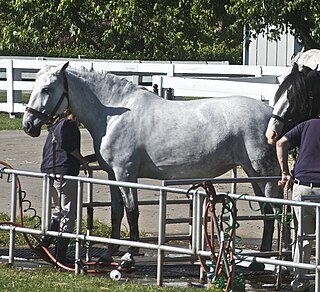
The Spanish-Norman horse is a warmblood horse breed that is the result of crosses between two much older breeds – the Andalusian of Spain and the Percheron of France. In 1991, a registry was created in Connecticut in the United States to maintain records of the breed. The Spanish-Norman is bred primarily as a sport horse.

The Pryor Mountains Wild Horse Range is a refuge for a historically significant herd of free-roaming mustangs, the Pryor Mountain mustang, feral horses colloquially called "wild horses", located in the Pryor Mountains of Montana and Wyoming in the United States. The range has an area of 39,650 acres (160.5 km2) and was established in 1968 along the Montana–Wyoming border as the first protected refuge dedicated exclusively for mustangs. It was the second feral horse refuge in the United States. About a quarter of the refuge lies within the Bighorn Canyon National Recreation Area. A group of federal agencies, led by the Bureau of Land Management, administers the range.

The Pryor Mountain mustang is a substrain of mustang considered to be genetically unique and one of the few strains of horses verified by DNA analysis to be descended from the original Colonial Spanish horses brought to the Americas by the Spanish. They live on the Pryor Mountains Wild Horse Range located in the Pryor Mountains of Montana and Wyoming in the United States, and are the only mustang herd remaining in Montana, and one of sixteen in Wyoming. They are protected by the Wild and Free-Roaming Horses and Burros Act of 1971 (WFRHBA) and managed by the Bureau of Land Management (BLM), who has set the optimum herd number at 120 animals. Genetic studies have revealed that the herd exhibits a high degree of genetic diversity and a low degree of inbreeding, and BLM has acknowledged the genetic uniqueness of the herd. Pryor Mountain Mustangs are relatively small horses, exhibit a natural ambling gait, and domesticated Pryor Mountain mustangs are known for their strength, sure-footedness and stamina. The Pryor Mountains Wild Horse Range is one of the most accessible areas to view feral horse herds in the United States and tourism to the area has increased in recent years.
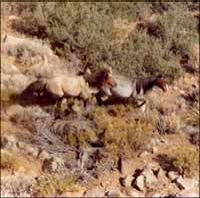
The Cerbat mustang is a feral horse population of Arizona, found in the Cerbat Herd Management Area in that state. Their main coat colors are chestnut, bay, and roan. While their phenotype is similar to the classic Colonial Spanish horse, the actual origin of Cerbat mustangs is unclear, but they have been identified by DNA testing as of Colonial Spanish horse ancestry, and they are recognized by the Spanish Mustang registry as valid foundation stock for that standardized breed. Cerbats possess the ability to gait.

The Lac La Croix Indian Pony (LLCIP), also known as the Ojibwe pony, is a semi-feral Canadian horse breed developed by the Ojibwe people. The population became critically low and by 1977, only four mares remained. To preserve the breed, these mares were crossed with Spanish Mustang stallions. The modern breed name derives from the Lac La Croix First Nation of Ontario, where the horses were last found in the wild. Historically, the breed was also found in Minnesota. Today it remains a critically endangered breed.
